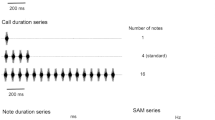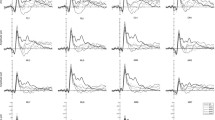Abstract
Thresholds for evoked vocal responses and thresholds of multiunit midbrain auditory responses to pure tones and synthetic calls were investigated in males of Pleurodema thaul, as behavioral thresholds well above auditory sensitivity have been reported for other anurans. Thresholds for evoked vocal responses to synthetic advertisement calls played back at increasing intensity averaged 43 dB RMS SPL (range 31–52 dB RMS SPL), measured at the subjects’ position. Number of pulses increased with stimulus intensities, reaching a plateau at about 18–39 dB above threshold and decreased at higher intensities. Latency to call followed inverse trends relative to number of pulses. Neural audiograms yielded an average best threshold in the high frequency range of 46.6 dB RMS SPL (range 41–51 dB RMS SPL) and a center frequency of 1.9 kHz (range 1.7–2.6 kHz). Auditory thresholds for a synthetic call having a carrier frequency of 2.1 kHz averaged 44 dB RMS SPL (range 39–47 dB RMS SPL). The similarity between thresholds for advertisement calling and auditory thresholds for the advertisement call indicates that male P. thaul use the full extent of their auditory sensitivity in acoustic interactions, likely an evolutionary adaptation allowing chorusing activity in low-density aggregations.





Similar content being viewed by others
Abbreviations
- BT:
-
Best threshold
- CD:
-
Compact disc
- CF:
-
Center frequency
- EVR:
-
Evoked vocal response
- RMS:
-
Root mean square
- SPL:
-
Sound pressure level
References
Beckers OM, Schul J (2004) Phonotaxis in Hyla versicolor (Anura, Hylidae): the effect of absolute call amplitude. J Comp Physiol A 140:869–876
Bee MA (2003) Experience-based plasticity of acoustically evoked aggression in a territorial frog. J Comp Physiol A 189:485–496
Boatright-Horowitz SI, Horowitz SS, Simmons AM (2000) Patterns of vocal interactions in a bullfrog (Rana catesbeiana) chorus: shared preferential responding to far neighbors. Ethology 106:701–712
Brzoska J, Obert H-J (1980) Acoustic signals influencing the hormone production of the testes in the grass frog. J Comp Physiol A 140:25–29
Brzoska J, Walkowiak W, Schneider H (1977) Acoustic communication in the grass frog (Rana t. temporaria L): calls, auditory thresholds and behavioral responses. J Comp Physiol A 118:173–186
Chu J, Marler CA, Wilczynski W (1998) The effects of arginine vasotocin on the calling behavior of male cricket frogs in changing social contexts. Horm Behav 34:248–261
García-Rutledge EJ, Narins PM (2001) Shared acoustic resources in an old world frog community. Herpetologica 57:104–116
Gerhardt HC, Klump G (1988) Phonotactic responses and selectivity of barking treefrogs (Hyla gratiosa) to chorus sounds. J Comp Physiol A 163:795–802
Gerhardt HC, Schwartz JJ (2001) Auditory tuning and frequency preferences in anurans. In: Ryan MJ (ed) Anuran communication. Smithsonian Inst Press, Washington, pp 73–85
Gerhardt HC, Bee MA (2007) Recognition and localization of acoustic signals. In: Narins PM, Feng AS, Fay RR, Popper AN (eds) Hearing and sound communication in amphibians. Springer, New York, pp 113–146
Gerhardt HC, Diekamp B, Ptacek M (1989) Inter-male spacing in choruses of the spring peeper, Pseudacris (Hyla) crucifer. Anim Behav 38:1012–1024
Goense JBM, Feng AS (2005) Seasonal changes in frequency tuning and temporal processing in single neurons in the frog auditory midbrain. J Neurobiol 65:22–36
Harrison P, Littlejohn MJ (1985) Diphasy in advertisement calls of Geocrinia laevis (Anura: Lepdactyllidae): vocal responses of males during playback. Behav Ecol Sociobiol 19:67–73
Labra A, Vidal MA, Solís R, Penna M (2008) Ecofosiología de Herpetozoos. In: Vidal MA, Labra A, Lamborot M, Ortiz JC (eds) Herpetología de Chile. Springer Science, Heidelberg (in press)
Lombard ER, Straughan IR (1974) Functional aspects of anuran middle ear structures. J Exp Biol 61:71–93
Marshall VT, Humfeld SC, Bee MA (2003) Plasticity of aggressive signaling and its evolution in male spring peepers, Pseudacris crucifer. Anim Behav 65:1223–1234
Megela-Simmons A (1984) Behavioral vocal response thresholds to mating calls in the bullfrog, Rana catesbeiana. J Acoust Soc America 76:676–681
Narins PM (1982) Effects of masking noise on evoked calling in the Puerto Rican Coqui (Anura: Leptodactylidae). J Comp Physiol A 147:439–446
Narins PM (2001) Ectothermy’s last stand: hearing in the heat and cold. In: Ryan MJ (ed) Anuran communication. Smithsonian Inst Press, Washington, pp 61–70
Narins PM, Capranica RR (1978) Communicative significance of the two-note call of the treefrog Eleutherodactylus coqui. J Comp Physiol A 127:1–9
Narins PM, Zelick RD (1988) The effects of noise on auditory processing and behavior in amphibians. In: Fritzsch B, Ryan MJ, WIlczynski W, Hetherington TE, Walkowiak W (eds) The evolution of the amphibian auditory system. Wiley, New York, pp 511–536
Owen PC, Perril SA (1998) Habituation in the green frog, Rana clamitans. Behav Ecol Sociobiol 44:209–213
Penna M, Narins PM (1989) Effects of acoustic overstimulation on spectral and temporal processing in the amphibian auditory nerve. J Acoust Soc Am 85:1617–1629
Penna M, Veloso A (1990) Vocal diversity in frogs of the South American temperate forest. J Herpetol 24:23–33
Penna M, Solís R (1998) Frog call intensities and sound propagation in the South American temperate forest region. Behav Ecol Sociobiol 42:371–381
Penna M, Palazzi C, Paolinelli P, Solís R (1990) Midbrain auditory sensitivity in toads of the genus Bufo (Amphibia-Bufonidae) with different vocal repertoires. J Comp Physiol A 167:673–681
Penna M, Capranica RR, Somers J (1992) Hormone-induced vocal behavior and midbrain auditory sensitivity in the green treefrog, Hyla cinerea. J Comp Physiol A 170:73–82
Penna M, Lin WY, Feng AS (1997) Temporal selectivity for complex signals by single neurons in the torus semicircularis of Pleurodema thaul (Amphibia-Leptodactylidae). J Comp Physiol A 180:313–328
Penna M, Narins PM, Feng AS (2005) Thresholds for evoked vocal responses of Eupsophus emiliopugini (Amphibia, Leptodactylidae). Herpetologica 61:1–8
Penna M, Marquez R, Bosch J, Crespo EG (2006) Nonoptimal propagation of advertisement calls of midwife toads in Iberian habitats. J Acoust Soc Am 119:1227–1237
Rose G, Brenowitz EA (1997) Plasticity of aggressive thresholds in Hyla regilla: discrete accommodation to encounter calls. Anim Behav 53:353–361
Schwartz JJ, Gerhardt HC (1998) The neuroethology of frequency preferences in the spring peeper. Anim Behav 56:55–69
Shofner WP, Feng AS (1981) Post-metamorphic development of the frequency selectivities and sensitivities of the peripheral auditory system of the bullfrog, Rana catesbeiana. J Exp Biol 93:181–196
Solís R (1994) Factores moduladores de las interacciones sociales acústicas de Pleurodema thaul. PhD thesis, Universidad de Chile, Santiago, Chile
Solís R, Penna M (1997) Testosterone levels and evoked vocal responses in a natural population of the frog Batrachyla taeniata. Horm Behav 31:101–109
Walkowiak W (2007) Call production and neural basis of vocalization. In: Narins PM, Feng AS, Fay RR, Popper AN (eds) Hearing and sound communication in amphibians. Springer, New York, pp 87–112
Wells KD, Schwartz JJ (2007) The behavioral ecology of anuran communication. In: Narins PM, Feng AS, Fay RR, Popper AN (eds) Hearing and sound communication in amphibians. Springer, New York, pp 44–86
Zelick RD, Narins PM (1985) Temporary threshold shift, adaptation, and recovery characteristics of frog auditory nerve fibers. Hear Res 17:161–176
Acknowledgments
Aníbal Martínez assisted with the data analysis of the behavioral experiments. This study was supported by FONDECYT grant 1040830 to Mario Penna. Nelson Velásquez conducted the electrophysiological recordings under the award of CONICYT fellowship D-21060849. The Servicio Agrícola y Ganadero (SAG) authorized capture of specimens of Pleurodema thaul for the electrophysiological recordings. The neurophysiological experiments comply with the “Principles of animal care” publication No. 86-23, revised 1985 of the National Institute of Health, and with the laws of animal welfare in Chile (Protocol CBA# 061 FMUCH)
Author information
Authors and Affiliations
Corresponding author
Rights and permissions
About this article
Cite this article
Penna, M., Velásquez, N. & Solís, R. Correspondence between evoked vocal responses and auditory thresholds in Pleurodema thaul (Amphibia; Leptodactylidae). J Comp Physiol A 194, 361–371 (2008). https://doi.org/10.1007/s00359-007-0312-0
Received:
Revised:
Accepted:
Published:
Issue Date:
DOI: https://doi.org/10.1007/s00359-007-0312-0




